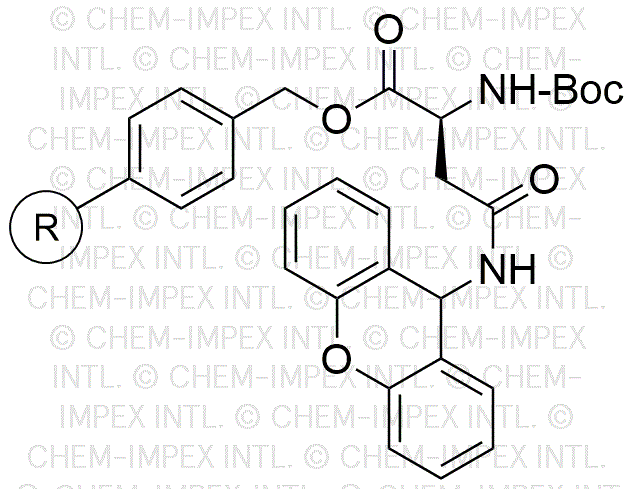Na-Boc-Ng-xanthyl-L-asparagine Merrifield resin is widely utilized in research focused on:
- Peptide Synthesis: This resin serves as a solid support for synthesizing peptides through the Merrifield method, allowing for the efficient assembly of amino acids into complex structures.
- Drug Development: Researchers leverage this resin to create peptide-based drugs, facilitating the discovery of new therapeutic agents for various diseases.
- Bioconjugation: It is used in bioconjugation processes, where peptides are attached to other biomolecules, enhancing the functionality of drugs and diagnostics.
- Protein Engineering: The resin aids in the design and production of modified proteins, which can be crucial for developing new biotechnological applications.
- Research in Cancer Therapeutics: Its application in synthesizing specific peptides allows scientists to explore targeted cancer therapies, potentially leading to more effective treatments.
General Information
Properties
Safety and Regulations
Applications
Na-Boc-Ng-xanthyl-L-asparagine Merrifield resin is widely utilized in research focused on:
- Peptide Synthesis: This resin serves as a solid support for synthesizing peptides through the Merrifield method, allowing for the efficient assembly of amino acids into complex structures.
- Drug Development: Researchers leverage this resin to create peptide-based drugs, facilitating the discovery of new therapeutic agents for various diseases.
- Bioconjugation: It is used in bioconjugation processes, where peptides are attached to other biomolecules, enhancing the functionality of drugs and diagnostics.
- Protein Engineering: The resin aids in the design and production of modified proteins, which can be crucial for developing new biotechnological applications.
- Research in Cancer Therapeutics: Its application in synthesizing specific peptides allows scientists to explore targeted cancer therapies, potentially leading to more effective treatments.
Documents
Safety Data Sheets (SDS)
The SDS provides comprehensive safety information on handling, storage, and disposal of the product.
Product Specification (PS)
The PS provides a comprehensive breakdown of the product’s properties, including chemical composition, physical state, purity, and storage requirements. It also details acceptable quality ranges and the product's intended applications.
Certificates of Analysis (COA)
Search for Certificates of Analysis (COA) by entering the products Lot Number. Lot and Batch Numbers can be found on a product’s label following the words ‘Lot’ or ‘Batch’.
Numéro de catalogue
Numéro de lot/série
Certificates Of Origin (COO)
This COO confirms the country where the product was manufactured, and also details the materials and components used in it and whether it is derived from natural, synthetic, or other specific sources. This certificate may be required for customs, trade, and regulatory compliance.
Numéro de catalogue
Numéro de lot/série
Safety Data Sheets (SDS)
The SDS provides comprehensive safety information on handling, storage, and disposal of the product.
DownloadProduct Specification (PS)
The PS provides a comprehensive breakdown of the product’s properties, including chemical composition, physical state, purity, and storage requirements. It also details acceptable quality ranges and the product's intended applications.
DownloadCertificates of Analysis (COA)
Search for Certificates of Analysis (COA) by entering the products Lot Number. Lot and Batch Numbers can be found on a product’s label following the words ‘Lot’ or ‘Batch’.
Numéro de catalogue
Numéro de lot/série
Certificates Of Origin (COO)
This COO confirms the country where the product was manufactured, and also details the materials and components used in it and whether it is derived from natural, synthetic, or other specific sources. This certificate may be required for customs, trade, and regulatory compliance.


